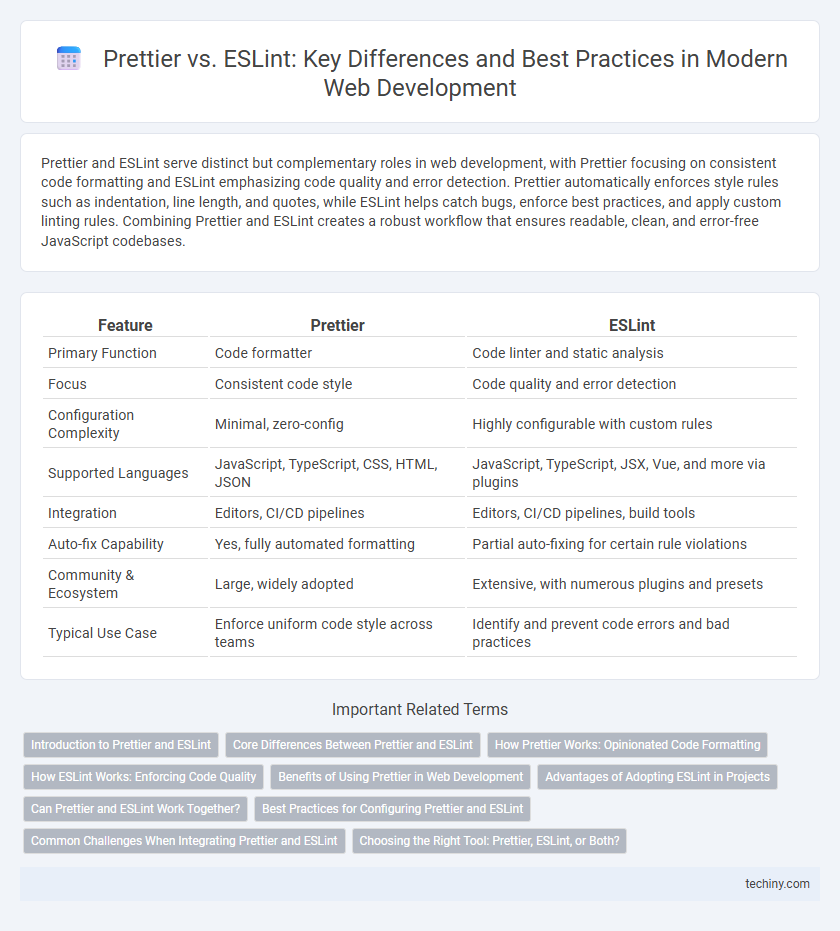Prettier and ESLint serve distinct but complementary roles in web development, with Prettier focusing on consistent code formatting and ESLint emphasizing code quality and error detection. Prettier automatically enforces style rules such as indentation, line length, and quotes, while ESLint helps catch bugs, enforce best practices, and apply custom linting rules. Combining Prettier and ESLint creates a robust workflow that ensures readable, clean, and error-free JavaScript codebases.
Table of Comparison
| Feature | Prettier | ESLint |
|---|---|---|
| Primary Function | Code formatter | Code linter and static analysis |
| Focus | Consistent code style | Code quality and error detection |
| Configuration Complexity | Minimal, zero-config | Highly configurable with custom rules |
| Supported Languages | JavaScript, TypeScript, CSS, HTML, JSON | JavaScript, TypeScript, JSX, Vue, and more via plugins |
| Integration | Editors, CI/CD pipelines | Editors, CI/CD pipelines, build tools |
| Auto-fix Capability | Yes, fully automated formatting | Partial auto-fixing for certain rule violations |
| Community & Ecosystem | Large, widely adopted | Extensive, with numerous plugins and presets |
| Typical Use Case | Enforce uniform code style across teams | Identify and prevent code errors and bad practices |
Introduction to Prettier and ESLint
Prettier is an opinionated code formatter that enforces consistent style by automatically parsing and reprinting code with its own rules, reducing stylistic debates in web development projects. ESLint is a powerful linting tool designed to identify and fix problematic patterns or code that doesn't adhere to coding standards, improving code quality and maintainability. Both tools integrate seamlessly into modern JavaScript workflows but serve distinct purposes: Prettier focuses on code formatting, while ESLint emphasizes code correctness and potential error prevention.
Core Differences Between Prettier and ESLint
Prettier is an opinionated code formatter designed to enforce consistent style by automatically formatting code based on predefined rules, focusing primarily on whitespace, line breaks, and indentation. ESLint serves as a static code analysis tool aimed at identifying and fixing problematic patterns or code errors, offering customizable rules for code quality, best practices, and potential bugs. While Prettier ensures uniform code style, ESLint extends beyond formatting to enforce coding standards, detect potential errors, and improve overall code quality in JavaScript and related environments.
How Prettier Works: Opinionated Code Formatting
Prettier is an opinionated code formatter that enforces a consistent style by parsing code and reprinting it with a fixed set of formatting rules. It eliminates debates over stylistic choices by automatically adjusting line breaks, indentation, and spacing based on a predetermined configuration. This approach ensures uniform code appearance across teams, reducing manual formatting errors and improving code readability in web development projects.
How ESLint Works: Enforcing Code Quality
ESLint enforces code quality by analyzing JavaScript and JSX code through a pluggable linting utility that detects syntax errors, coding standard violations, and potential bugs. It uses customizable rules and configurations to automatically identify and fix issues, promoting consistent code style and preventing runtime errors. By integrating with IDEs and CI/CD pipelines, ESLint ensures continuous code quality monitoring throughout the development process.
Benefits of Using Prettier in Web Development
Prettier enforces consistent code formatting by automatically formatting code according to predefined rules, reducing style debates and code review time. It integrates seamlessly with popular editors and CI/CD pipelines, ensuring uniformity across development teams. By handling formatting, Prettier allows developers to focus on code quality and functionality rather than stylistic concerns.
Advantages of Adopting ESLint in Projects
ESLint enhances code quality by enforcing consistent coding standards and identifying potential errors early in the development process. Its customizable rule sets and plugin ecosystem allow teams to tailor linting to specific project requirements, improving maintainability and reducing debugging time. Integrating ESLint with continuous integration pipelines ensures automated code review, promoting best practices and reducing technical debt across large codebases.
Can Prettier and ESLint Work Together?
Prettier and ESLint can work together seamlessly in web development environments by handling different aspects of code quality; Prettier focuses on automatic code formatting while ESLint enforces coding standards and detects potential errors. Integration tools like eslint-config-prettier disable conflicting rules in ESLint, allowing Prettier's formatting to take precedence without interference. Combining both tools improves code consistency, readability, and maintainability across JavaScript and TypeScript projects.
Best Practices for Configuring Prettier and ESLint
Configuring Prettier and ESLint effectively involves setting Prettier as the primary code formatter and enabling ESLint for code quality and linting rules to avoid conflicts. Use eslint-config-prettier to disable ESLint rules that might interfere with Prettier formatting and ensure consistent styles by integrating Prettier into the ESLint workflow via eslint-plugin-prettier. Establish shared configuration files, enforce consistent formatting in CI pipelines, and customize rules per project requirements to maintain high code quality and readability.
Common Challenges When Integrating Prettier and ESLint
Common challenges when integrating Prettier and ESLint include configuration conflicts where both tools try to enforce formatting rules, causing inconsistencies and errors during code linting or formatting. Developers often encounter overlapping rules for indentation, semicolons, and spacing, requiring careful rule customization and plugin setups like eslint-config-prettier to disable conflicting ESLint rules. Ensuring smooth integration demands synchronized configurations and running Prettier as a code formatter alongside ESLint's static analysis to maintain code quality and style consistency.
Choosing the Right Tool: Prettier, ESLint, or Both?
Prettier focuses on code formatting, enforcing consistent style rules like line length, indentation, and spacing, while ESLint analyzes code for potential errors and enforces best practices through customizable linting rules. Choosing Prettier alone simplifies formatting and reduces stylistic debates, whereas ESLint enhances code quality by catching bugs and enforcing coding standards beyond formatting. Combining both tools provides a robust workflow, where Prettier handles automatic formatting and ESLint ensures code correctness, improving maintainability and developer productivity in web development projects.
Prettier vs ESLint Infographic

 techiny.com
techiny.com